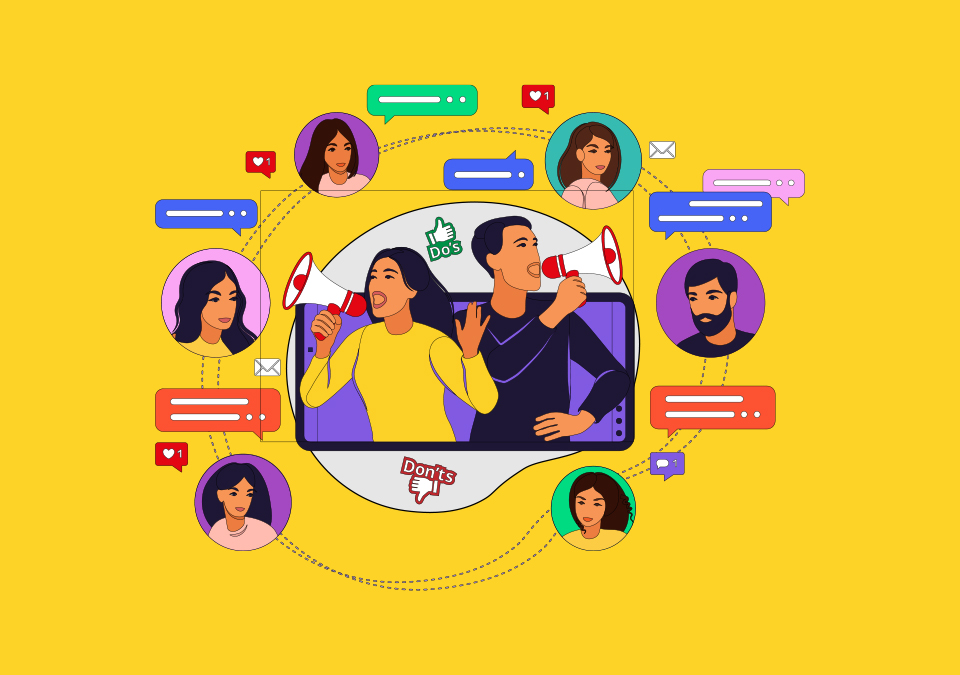The Do’s and Don’ts of Influencer Partnerships

Categories:
Social MediaTags:
Social MediaIf you’re a business looking to promote your brand to a new audience, it is imperative that you pay heed to Social Media and build your presence on social media platforms. Not sure why? Here’s a fact. A Nielsen report published in 2021, titled “Beyond martech: building trust with consumers and engaging where sentiment is high” revealed that the average consumer spends at least 2 hours a day on social media. This is a 2-hour window your brand can capitalize on to establish its presence in the minds of everyday consumers.
So how do you do this? Social Media is a gigantic space and once you’re done with the basics, you’ll need to resort to different strategies to reach out to different audiences. One of the ways to do this is influencer marketing. Influencers are considered among the best ways for a brand to reach their target audience and make an impact. But this isn’t just about hiring an influencer and making a post for their audience. You’ll want to build meaningful influencer partnerships and relationships with them so that they understand and appreciate your brand and its value proposition. Here’s a simple guide on how you can do this.
Do’s
Hire the right influencers
The most important aspect of influencer marketing strategy is to hire the right influencer. Quite simply put, this is the most basic and important step in influencer marketing. Every influencer, whether they’re a celebrity or a micro influencer, has a unique target audience they cater to. They have acquired this audience by creating content that appeals to such an audience. For instance, MKBHD is a tech influencer, so he caters to audiences that are interested in technology products such as electronics, gadgets and devices. If you’re a fashion brand, you will NOT want to approach an MKBHD or a Dave2D to promote your products. Instead, it will make sense for you to approach a fashion blogger or a model with a substantial following.
Keep it transparent and concise with your communication
Ensure you aren’t vague with your influencer marketing partners. Remember that at the end of the day, social media influencers are also content creators and they cater to their own audience. You will want to make sure your brand guidelines, communication strategy and identity are clearly communicated to influencers you’ve partnered with. This will ensure your brand’s identity isn’t diluted and more importantly, it will help you identify and work with influencers who are in alignment with your brand’s identity and target audience
Respect the influencer’s content and profession
Influencers are also doing a job and have gained the following they have because of the quality of their content. It’s important to respect that they’re talented content creators who know their target audience well and represent the interests of their followers when it comes to their niche of content. It’s important for the brand to respect this. Just as the brand’s content guidelines and identity mustn’t get diluted with the campaign, so mustn’t the influencer’s own content identity.
Foster Genuine Relationships With Influencers
Don’t just treat influencers as one-time promoters. Building a genuine relationship with them can go a long way into establishing your brand’s value among their followers. The more an influencer trusts your brand, the likelier their followers are to engage with your brand. This will also help you with any future collaborations with these influencers.
Monitor and Measure the Results of Each Influencer Campaign
Once the influencer marketing campaign has reached its conclusion, it’s always advisable to take a moment to analyze and assess the campaign. Set clear goals for the campaign, whether your aim is to increase brand awareness, drive sales or promote a new product and measure the campaign’s performance as per your goal.
Ensure that the Influencers are Following Guidelines
Influencers can’t just promote a brand with all their content. They have to disclose whenever they’ve collaborated with a brand to promote their products through their content. Ensure that whichever influencers you’re partnering with are following the established advertising guidelines on their respective platforms and are transparent with their audience.
Don’ts
Rely on follower count
Don’t make the mistake of assuming the influencer with the highest follower count will get you the best results. It’s important to analyze whether or not the influencer caters to your target audience, and how much of their audience engages with their posts consistently. Sometimes, influencers tend to buy followers and these followers are unlikely to actively engage with the influencer’s content.
Go overboard with “creative freedom”
Yes, it’s important to give the influencers and their content the respect they deserve. It is also important for the brand and its product’s identity to be reflected through the influencer campaign. It’s all about striking the right balance between content and promotion. If you allow the influencer to take the driving seat and don’t provide clear instructions and guidelines, it’s unlikely the campaign will succeed.
Underpay or sell the influencer short
Most brands make the mistake of assuming the influencer is in it for the “free stuff” and just make a social media post which doesn’t require a lot of effort. As previously mentioned, they’re not just influencers for a brand, they’re content creators with an audience they’ve worked hard to build through high-quality content. Content their audience appreciates. It’s important to acknowledge that a simple post by an influencer has a lot of careful planning and execution behind it. This is especially true for posts that are brand collaborations. Every influencer has their own rate. If you feel their rate is too high, respect their valuation for their service and seek out another influencer. Don’t try to bargain or sell them short with poor offers and especially avoid commenting on the “effort” their work requires of them.
Try to control every aspect of the content
As previously mentioned, there are plenty of brands that simply believe a single post by an influencer endorsing or reviewing their brand is enough. While it’s important to avoid leaving it entirely up to the influencer, it is also important to issue clear communication to the influencer and ensure your brand’s identity isn’t diluted through the content. The influencer knows their own art style and content strategy, but they must also be familiar with yours when they’re executing the social media influencer marketing campaign.
Conclusion
Always remember that influencer marketing is only as effective as your approach to the campaign. Choose the right influencer and ensure they receive clear instructions from your business to maintain a consistent and balanced tone between brand identity and influencer content. According to Nielsen, 88% of consumers trust people over brands when it comes to product purchase decisions. You’ll want the right person representing your brand in order to succeed.





